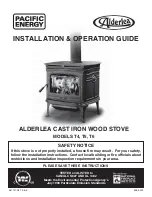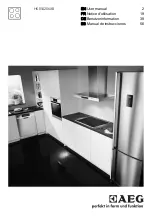
|15
14
EN
6. INSTALLING THE STOVE
Note
Assembly may only be performed by authorised specialist
companies�
Note
Please observe the regional safety and building regulations� Please
contact your master chimney sweep in this context�
Note
Only use heat-resistant sealing materials as well as corresponding
sealing strips, heat-resistant silicon and rock wool�
Note
Also take care that the flue does not project into the free cross-
section of the chimney�
Note
In case of room-air independent operation the stove pipe
connections must be tightly sealed permanently� Use a heat-proof
silicon to position the stove pipe on the conical supports of the flue
tube nozzles and for insertion in the chimney flue lining�
Note
The stove should not be pushed on unprotected floors�
Tip
Strong corrugated cardboard, cardboard or e�g� old carpet is useful
to assist assembly and as a base� The stove can also be pushed on
this cardboard or carpet�
We recommend original flue pipes from RIKA for proper connection�
Connection to the chimney
Q
The device must be connected to a flue that is approved for solid
fuels and is insensitive to moisture� The moisture insensitivity may
vary if the flue calculation results in a dry operation� The chimney
must have a diameter of min� 100 mm for pellet stoves and
130 mm -150 mm for log wood stoves depending on the diameter
of the flue pipes�
Q
Avoid long flue pipes to the chimney� The horizontal length of the
flue pipe should not exceed 1�5 metres�
Q
Avoid to many bends of the flue gas pipes� There should not be
more than 3 bends in the exhaust pipe�
Q
Please use a connection with a cleaning opening�
Q
Connections must be made of metal and must meet the
requirements of the standard (install the connections airtight)�
Q
Before installing a chimney calculation must be made� The
evidence must be performed for single occupancy to EN13384-1
and EN13384-2 for multiple occupancy�
Q
The maximum draft of the chimney should not exceed 15 Pa�
Q
The derivation of the flue gases must be guaranteed even during
a temporary power outage�
Note
If connecting to multiple connection chimneys and depending on
country regulations, additional safety equipment is required� Your
local chimney sweep will advise you in this case�
Note
Be sure to prevent condensed water from entering via the flue
connection� You may need to have a condensate ring installed -
ask your chimney sweeping expert for more information� Damages
caused by condensate are excluded from manufacturer’s warranty�
Connecting to a steel chimney
The connection must be calculated and shown with EN13384-1
and EN13384-2�
Use only insulated (double) stainless steel tubes (flexible aluminum
or steel tubes are not permitted)�
An inspection door for regular inspection and cleaning must be
present�
The flue pipe connection to the chimney has to be air-tight�
Combustion air
Every combustion process requires oxygen from the surrounding air�
This so-called combustion air is removed from the living are in the
case of individual stoves without external air connections�
This air removed must be replaced in the living space� Very tightly
sealed windows and doors in modern flats may mean that too little
air replaces that used� The situation also becomes problematical due
to additional venting in flats (e�g� in the kitchen or WC)� If you cannot
feed in external combustion air, then air the room several times a
day to prevent negativce pressure in the room or poor combustion�
Feeding in external combustion air
only for devices which are able to run in room-air independent
operation�
Q
Combustion air must be fed to the stove from outside via a sealed
pipe for operation independent of the room air� According to
EnEV, it must be possible to shut off the combustion air pipe� The
open/closed setting must be clearly recognisable�
Q
Connect at the air intake either a pipe Ø 125 mm for log wood and
combi stoves, or Ø 50 mm or Ø 60 mm for pellet stoves� Fix it with
a hose clamp (not included!)� At pellet stoves with longer intake
pipes than 1 m the diameter should be increased to 100 mm� (see
RIKA range)�
Q
To ensure sufficient air intake, the intake pipe should not exceed
max� 4 metres and have max� 3 bends�
Q
If the line leads outside it must have a windbreak�
Q
In extreme cold pay attention to icing on the air intake opening
(check)�
Q
It is also possible to suction in combustion air directly from
another sufficiently vented room (e�g� cellar)�
Q
The combustion air pipe must be tightly connected (adhesive or
cement) permanently to the air nozzles of the stove�
Q
If you do not use the stove for a long time, please close the
combustion air intake to prevent the stove from moisture�
Note
Please note that problems may arise due to updrafts in the case
of combustion air supply from an integrated chimney ventilation
shaft� If the combustion air flowing downwards is heated it may
rise and thus counter the chimney with a resistance which in turn
reduces the negative pressure in the combustion chamber� The
chimney manufacturer is to guarantee that the resistance for the
combustion air is a maximum 2 Pa even in the least favourable
operating state of the chimney�
If one or more of these conditions does NOT apply, the result is poor
combustion in the stove and negative pressure in the installation
room�
Содержание ALUMO
Страница 1: ...ALUMO Operating manual...
Страница 10: ...63 63 52 65 64 62 62 59 60 61 58 57 57 67 60 61 66 54 51 56 56 53 50 55 75 76 74 72 70 71 73 77...
Страница 23: ...23 22 EN...










































